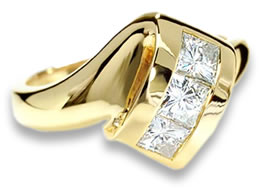|
Reviewed By Andreas Zabczyk
Synthetic MoissaniteMany different materials, both natural and synthetic, have been offered as diamond simulants - lower-cost gems that imitate diamond. None of them were really successful until cubic zirconia (often known as CZ) hit the market in 1976. Due to its convincing diamond-like appearance and low cost, it was a huge market success. 
Synthetic Moissanite
CZ had virtually no competition until 1998 when another material called moissanite was introduced to the market. Moissanite does occur as a natural mineral, but it is extremely rare and is found in tiny quantities, mainly in meteorites. By chemical composition it is silicon carbide. Silicon carbide was first synthesized by Jons Jacob Berzelius (1779-1848), a Swedish chemist, who is best known for his discovery of silicon. All of the moissanite currently sold on the market is synthetic. As a diamond simulant, moissanite is superior to cubic zirconia in two ways. First, moissanite's hardness (8.5 to 9.25 on the Mohs scale) is closer to that of diamond; CZ by comparison has a hardness of 8 to 8.5. This difference in hardness affects not only durability, but also moissanite's appearance - a cut moissanite has facets that are nearly as crisp as those of a diamond. 
Moissanite Earrings in White Gold
Secondly, moissanite's density more closely approximates diamond. Moissanite has a specific gravity of 3.2, which is fairly close to that of diamond (3.5 to 3.53). Cubic zirconia, by contrast, is extremely dense, with a specific gravity of 5.6 to 6. Therefore, a 1 carat CZ is much smaller than a 1 carat diamond. Moissanite has been heavily promoted in the marketplace by the one company that produces gem-quality material; Charles & Colvard. Though moissanite represents an advance over cubic zirconia, it does have some shortcomings. Diamond is a singly refractive material, as is CZ. But moissanite, like most gemstones, is double refractive. All moissanite is cut with the table perpendicular to the optic axis in order to hide this property, but when viewed under magnification at only a slight tilt the doubling of facets is easily visible. 
Moissanite in Yellow Gold Ring
Moissanite, like diamond, is a thermal conductor. So the diamond testers designed to distinguish diamond simulants like cubic zirconia will not identify moissanite. New diamond testers had to be introduced, which included an electrical conductivity tester that could differentiate between diamond and moissanite. Moissanite's other shortcomings may eventually be overcome. One issue is a color problem; current moissanite production is plagued by an inescapable tint, which is usually a brownish-green. The other issue is cost - the limited availability of moissanite makes it about 120 times more expensive than cubic zirconia. So Charles & Colvard is trying to market moissanite not as a diamond simulant, but as a gemstone in its own right. This Page in Other Languages
|
| STAY IN TOUCH | NEWSLETTER |
| *You're signing up to receive GemSelect promotional email. |
Copyright © 2005-2024 GemSelect.com all rights reserved.
Reproduction (text or graphics) without the express written consent of GemSelect.com (SETT Company Ltd.) is strictly prohibited.
1104